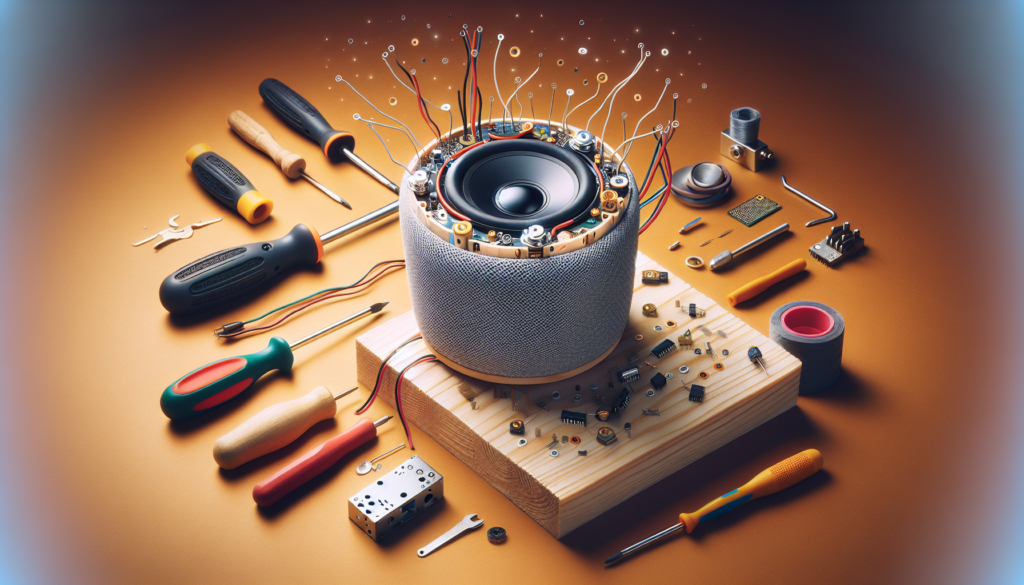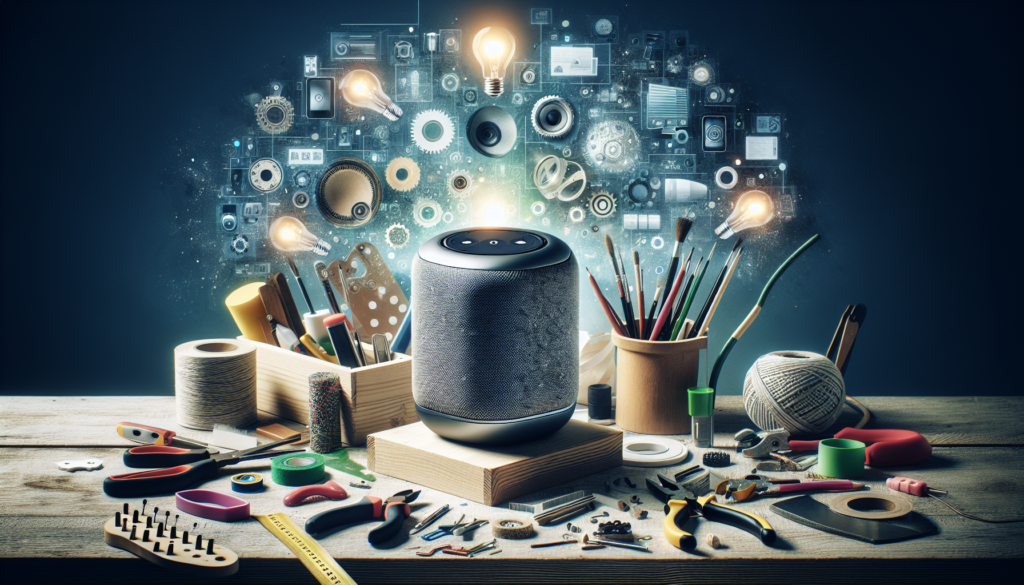Have you ever wondered if there are any do-it-yourself projects that can enhance the functionality of your smart speakers? Well, we’ve got great news for you! In this article, we will explore various innovative DIY projects that not only maximize the potential of your smart speakers but also add a touch of personalization to your smart home setup. From custom voice commands to interactive light displays, these projects will surely take your smart speaker experience to the next level. So, roll up your sleeves and get ready to unleash your creativity as we dive into the world of DIY projects for smart speakers! Yes, there are numerous DIY projects that can enhance the functionality of smart speakers. Whether you want to customize voice commands, improve audio quality, add touchscreens, or integrate with other devices, there are options available to suit your needs. In this article, we will explore various DIY projects that can take your smart speaker experience to the next level. From creating custom voice commands to enhancing privacy settings, we will cover a wide range of projects that you can undertake to maximize the potential of your smart speakers. So, let’s dive in and explore the exciting world of DIY projects for smart speakers!

Voice Commands and Smart Home Automation
Creating Custom Voice Commands
One of the great advantages of smart speakers is their ability to recognize and respond to voice commands. However, the default voice commands may not always align with your preferences or needs. Thankfully, you can create custom voice commands to suit your specific requirements. By leveraging open-source platforms and programming languages like Python, you can modify or add new voice commands to your smart speaker. Whether you want to control specific devices or automate certain tasks, custom voice commands allow for a truly personalized experience.
Integrating with Home Automation Systems
Smart speakers provide a convenient way to control various smart home devices, such as lights, thermostats, and security systems. However, to maximize the integration of these devices, you can explore DIY projects that allow for seamless communication between your smart speaker and your home automation system. By leveraging APIs and programming interfaces, you can create custom workflows and interactions that enhance the overall automation capabilities of your smart home. This integration enables you to have greater control over your home environment using voice commands.
Controlling Smart Home Devices
While smart speakers offer native support for many devices, there may be instances where you want to control devices that are not officially supported. In such cases, DIY projects can help you bridge the gap by creating custom control mechanisms for your smart home devices. Using platforms like Arduino or Raspberry Pi, you can build custom interfaces that communicate with your smart speaker and allow for control of unsupported devices. This opens up a whole new world of possibilities and extends the functionality of your smart speaker to previously incompatible devices.
Audio Enhancements
Building a Speaker Stand or Mount
To truly optimize the audio quality of your smart speaker, you can create a custom speaker stand or mount. By designing a stand that complements the speaker’s form and enhances sound projection, you can create an immersive audio experience in your home. DIY speaker stands can be constructed using various materials such as wood or metal, and you can customize the design to match your aesthetic preferences. Additionally, by positioning the speaker at the right height and angle, you can ensure optimal audio dispersion throughout the room.
Creating Surround Sound
If you’re looking to take your audio experience to the next level, building a surround sound setup using your smart speaker can be a fantastic DIY project. By strategically placing multiple smart speakers around your space, you can create an immersive audio environment that enhances your movie nights or music listening sessions. With the right setup and proper calibration, you can enjoy a truly cinematic audio experience right in your living room.
Using External Audio Systems
While smart speakers generally offer decent audio quality, some enthusiasts may prefer a more robust audio setup. In that case, you can opt to connect your smart speaker to external audio systems. By utilizing the auxiliary or Bluetooth connections available on most smart speakers, you can hook them up to larger, more powerful speakers or audio systems. This allows for greater control over audio output and enables you to enjoy your favorite music or movies in high fidelity.

Smart Displays and Touchscreens
Adding a DIY Touchscreen Overlay
If you wish to augment the capabilities of your smart speaker with a touchscreen interface, a DIY touchscreen overlay can be the perfect solution. By adding a touchscreen overlay to your smart speaker, you can enjoy additional functionalities such as gesture-based control, on-screen navigation, and visual feedback. DIY touchscreen overlays can be constructed using transparent materials and touch-sensitive panels. With the right tools and instructions, you can integrate a touchscreen seamlessly onto your smart speaker, enhancing its interactivity.
Customizing Smart Display Interfaces
Smart displays offer a visual element to the smart speaker experience, providing information and visuals to supplement voice command interactions. To enhance this aspect, you can customize the smart display interfaces of your smart speaker. Whether it’s changing the layout, adding widgets or customizing the colors and fonts, DIY projects allow you to personalize the display to your liking. By modifying the user interface, you can optimize the information presented and improve overall usability.
Designing a Custom Stand or Mount
Adding a custom stand or mount to your smart display not only enhances its aesthetics but also improves functionality. A DIY project to design and build a stand or mount allows you to create a personalized solution that meets your specific needs. Whether you want a wall-mounted display or an adjustable stand, you can bring your ideas to life using readily available materials and tools. This enables you to position the smart display in a way that best suits your viewing requirements and complements the overall decor of your home.
Smart Speaker Accessories
Building a Portable Battery Pack
An excellent DIY project to enhance the portability of your smart speaker is to build a portable battery pack. By creating a battery pack that connects to your smart speaker, you can use it wirelessly and carry it anywhere in your home. This allows for greater flexibility when it comes to placing the speaker or taking it to outdoor gatherings. DIY battery packs can be constructed by leveraging power banks or rechargeable batteries, ensuring that your smart speaker remains functional even without a direct power source.
Creating a DIY Wireless Charger
If you prefer a futuristic and clutter-free charging setup for your smart speaker, a DIY wireless charger can be a practical solution. By incorporating wireless charging technology into your smart speaker, you eliminate the need for cables and connectors. DIY wireless chargers can be built using induction coils and compatible charging modules. With some basic electronics knowledge and the right components, you can enjoy the convenience of wireless charging for your smart speaker.
Designing a Custom Speaker Cover
To add a touch of uniqueness to your smart speaker, you can embark on a DIY project to design and create a custom speaker cover. Whether it’s a fabric cover, a wooden case, or a 3D-printed shell, a custom speaker cover allows you to personalize the appearance of your smart speaker. This not only enhances its aesthetics but also offers protection from dust and scratches. By designing your own speaker cover, you can showcase your creativity and tailor the design to match your home decor.

Voice Assistant Integration
Adding Multiple Voice Assistants
If you have multiple voice assistants at your disposal, such as Google Assistant, Amazon Alexa, or Apple Siri, you can explore DIY projects that enable the integration of these assistants into your smart speaker. By utilizing open-source libraries and APIs, you can develop custom scripts or workflows that allow for seamless switching between different voice assistants. This integration enables you to leverage the unique strengths and features of each assistant, enhancing the overall capabilities of your smart speaker.
Integrating with Mobile Devices
To create a more connected experience between your smart speaker and your mobile devices, you can undertake DIY projects to enable deeper integration. By utilizing platforms like Tasker for Android or Shortcuts for iOS, you can establish custom automation routines that bridge the gap between your smart speaker and your smartphone or tablet. This integration allows for enhanced control and synchronization of various functions, such as media playback, notifications, or home automation tasks.
Creating Custom Wake Words
If you’re not satisfied with the default wake word of your smart speaker, you can explore DIY projects that enable the creation of custom wake words. By leveraging speech recognition technologies and machine learning algorithms, you can train your smart speaker to respond to a unique phrase or keyword of your choice. DIY wake word creation projects often involve recording and processing large datasets to build a robust wake word model that can accurately recognize and respond to your custom wake word.
Custom Voice Responses and Skills
Programming Custom Responses
To add a personal touch to your smart speaker’s responses, you can undertake DIY projects to program custom voice responses. By leveraging voice synthesis technologies and programming languages, you can create unique phrases or responses that reflect your personality or preferences. Whether it’s an inside joke or a personalized greeting, custom voice responses make the interaction with your smart speaker more engaging and enjoyable.
Developing Smart Speaker Skills
Smart speakers offer a wide range of skills or actions that allow for various functionalities, such as playing music, providing weather updates, or controlling smart home devices. However, you can take it a step further by developing your own custom skills for your smart speaker. By utilizing development frameworks like Alexa Skills Kit or Google Actions, you can design and implement unique skills that cater to your specific needs or interests. This DIY project empowers you to create voice-driven experiences that are tailored to your preferences, expanding the capabilities of your smart speaker.
Building Voice Games and Quizzes
If you enjoy gaming or want to engage with your smart speaker in a more interactive manner, creating voice-enabled games or quizzes can be a fun and challenging DIY project. By leveraging programming languages like Python or utilizing voice game development platforms, you can design and build custom voice games or quizzes. Whether it’s a trivia game, a storytelling adventure, or a quiz to test your knowledge, DIY voice games and quizzes allow you to explore the entertainment potential of your smart speaker.

Privacy and Security Enhancements
Building a Smart Speaker Enclosure
Privacy and security are essential aspects to consider when using smart speakers. To address these concerns, you can build a custom enclosure for your smart speaker. An enclosure not only protects the internal components but also prevents unauthorized access to the device. DIY smart speaker enclosures can be constructed using various materials, such as wood or acrylic, and can be designed to blend seamlessly with your home decor. Additionally, you can incorporate features like physical mute switches or LED indicators to further enhance privacy and security.
Enhancing Privacy Settings
In addition to physical enclosure solutions, you can undertake DIY projects to enhance the privacy settings of your smart speaker. By configuring advanced privacy options or implementing additional security measures, you can ensure that your personal data and conversations are kept private. DIY privacy enhancements can involve techniques like setting up a local voice recognition system, utilizing encryption protocols, or customizing data storage and deletion processes. These projects give you greater control over your privacy settings, providing peace of mind while using your smart speaker.
Securing Voice Assistant Data
To reinforce the security of your smart speaker’s voice assistant and its associated data, you can explore DIY projects that focus on securing voice assistant data. By implementing encryption measures, utilizing secure communication protocols, or leveraging hardware security modules, you can enhance the protection of sensitive information and prevent unauthorized access. DIY security enhancements allow you to take an active role in safeguarding your voice assistant data, ensuring that your interactions remain confidential and secure.
Multi-room Audio Setup
Creating a Multi-room Speaker System
If you want to enjoy synchronized audio playback throughout your home, creating a multi-room speaker system using your smart speakers can be a rewarding DIY project. By leveraging technologies like Wi-Fi or Bluetooth, you can connect multiple smart speakers and synchronize their audio output. This allows you to seamlessly transition from one room to another while enjoying your favorite songs, podcasts, or audiobooks. DIY multi-room audio setups empower you to create a vibrant, immersive audio experience that fills your entire living space.
Syncing Smart Speakers
In a multi-room audio setup, it is crucial to ensure that all your smart speakers are perfectly synced to avoid audio delays or interruptions. DIY projects that focus on syncing smart speakers involve fine-tuning synchronization settings, utilizing network optimizations, or leveraging audio calibration tools. By meticulously matching audio playback timings across multiple speakers, you can achieve a seamless and immersive audio experience that enhances your enjoyment of music or multimedia content.
Building a DIY Sound Bar
If you prefer a more compact setup to complement your TV or home theater system, building a DIY sound bar using smart speakers can be a fantastic project. By designing and constructing a custom sound bar enclosure that accommodates your smart speakers, you can enhance your audio experience while watching movies or TV shows. DIY sound bars can be built using materials like wood or acrylic and can be customized to match your existing audio setup. This DIY project allows you to create a sleek and powerful sound bar that seamlessly integrates with your entertainment system.

Smart Speaker Voice Training
Improving Voice Recognition Accuracy
Smart speakers rely on voice recognition software to accurately understand and respond to your commands. However, in certain situations, the voice recognition accuracy may not meet your expectations. To address this, DIY projects for voice training can help improve the accuracy of voice recognition on your smart speaker. Techniques like retraining the voice model using personalized voice data or adjusting the microphone sensitivity can significantly enhance the performance of your smart speaker. By undertaking voice training DIY projects, you can ensure that your smart speaker accurately understands your commands, improving your overall user experience.
Training Smart Speakers for Accents
Accents can sometimes pose a challenge for smart speakers, leading to decreased accuracy in voice recognition. If you have a distinctive accent or use a language variant that is not widely supported, DIY projects for accent training can be incredibly useful. By providing the smart speaker with voice samples specific to your accent or dialect, you can train it to recognize and interpret your commands more accurately. This DIY project allows you to overcome accent-related barriers and enjoy a seamless voice interaction experience with your smart speaker.
Teaching New Words and Phrases
Smart speakers come equipped with a vast vocabulary and the ability to understand a wide range of words and phrases. However, there may be instances where you want your smart speaker to recognize and interpret specific words or phrases unique to your needs. In such cases, DIY projects for teaching new words and phrases can be a great solution. By utilizing the training features available on certain smart speaker platforms, you can familiarize your device with new vocabulary, acronyms, or niche terms. This DIY project ensures that your smart speaker understands and responds to your specific linguistic requirements, making your interactions even more personalized.
Smart Speaker Language Customization
Changing Voice Assistant Languages
If you prefer to use your smart speaker in a language other than the default, DIY projects for language customization can help you achieve that. By modifying the language settings of your smart speaker, you can change the voice assistant’s language to one that you are more comfortable with. DIY language customization may involve adjusting system settings, installing language packs, or leveraging third-party tools or libraries. This allows you to interact with your smart speaker using your preferred language, enhancing the overall user experience.
Adding Multilingual Support
In households or environments where multiple languages are spoken, adding multilingual support to your smart speaker can be highly beneficial. DIY projects for multilingual support involve configuring your smart speaker to understand and recognize commands in different languages. By customizing language settings, enabling language detection, or creating language-specific voice profiles, you can ensure that your smart speaker responds accurately to commands spoken in different languages. This enables seamless communication and accessibility for multilingual users, making the smart speaker experience more inclusive.
Integrating Translation Services
Smart speakers already offer built-in translation capabilities for a limited set of languages. However, if you want to expand the translation capabilities or add support for languages that are not natively available, you can undertake DIY projects to integrate translation services into your smart speaker. By utilizing translation APIs, cloud services, or open-source libraries, you can improve the real-time translation capabilities of your smart speaker. This DIY project enables you to bridge language barriers and engage in conversations or interactions across different languages, expanding the functionality of your smart speaker.
In conclusion, DIY projects offer exciting opportunities to enhance the functionality and capabilities of smart speakers. Whether it’s customizing voice commands, improving audio quality, adding touchscreens, or integrating with other devices and platforms, there are numerous projects available to suit your preferences and needs. From building speaker stands to developing custom voice responses, from enhancing privacy settings to creating multi-room audio setups, the possibilities for DIY projects are vast. By exploring these projects and leveraging your creativity and technical skills, you can maximize the potential of your smart speakers and create a truly personalized and immersive smart home experience. So, roll up your sleeves, gather your tools, and embark on the exciting journey of DIY projects for smart speakers!










